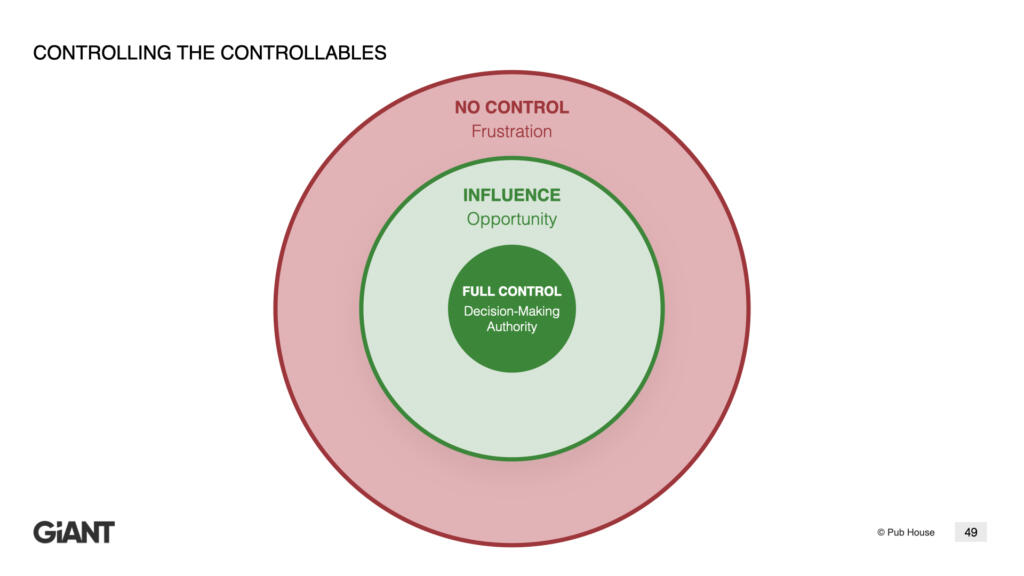
Out of Control: Controlling the Controllables
There are things in all of our lives that are beyond our control. Some of these things are easy to let go of while others can put us in a tailspin of anger, frustration, and worry. So, what do you do when things are out of control? We have a GiANT Tool we use called Controlling the Controllables that will help you manage yourself and the things in and out of your control.
“If you try to control everything, and then worry about the things you can’t control, you are setting yourself up for a lifetime of frustration and misery” is a helpful quote from an unknown source. Here are some easy strategies for you to take in managing what you can control and what is out of your control:
- Acceptance & Getting Your Bearings
- Identify What You Can Control: Decision-Making Authority
- Identify Where You Have Influence: Area of Influence
- Manage What Is Out of Your Control: No Control
Acceptance & Getting Your Bearings
A wise person once told me that the first step in dealing with frustration is the acceptance of whatever the frustration is. When it comes to “Flight or Fight,” I am a natural fighter so I want to fight every tough situation in my life. However, over the years I have learned this approach is not helpful most of the time. When I am dealing with something that is out of my control, my first step is accepting it is out of my control.
Reinhold Niebuhr wrote the original Serenity Prayer for a sermon then used it in many forms. The best-known version of it is:
God, grant me the serenity to accept the things I cannot change,
Courage to change the things I can,
And wisdom to know the difference.
This prayer goes hand in hand with the pictured Controlling the Controllables tool below because when things get stressful and you begin to feel a sense of becoming overwhelmed this tool is a helpful resource to put things into perspective. It allows you to get your bearings of where you have control and what things are out of your control. Let’s break it down…

Identify What You Can Control: Decision-Making Authority
In some situations, we have total control of circumstances and outcomes. We hold the keys, through our own actions and decision-making, to create different results. In this case, the center circle of the Controlling the Controllables tool is a reminder that you have the power to move the needle to create the outcome you want. This is the easy one because it’s all up to you. You have full control.
Something to keep in mind when you have full control over a situation is not to get in your own way. Having full control over something does not mean that no one else is involved in making decisions. Some of the best leaders manage this area of decision-making authority by giving their teams opportunities to make decisions as well. Sure, you still have the final say if needed but you are empowering those you lead. You are also raising other leaders by following this strategy.
Identify Where You Have Influence: Area of Influence
The middle circle is a reminder that there are times when you may not have the ability to control the situation, but you do have some level of influence on those who can. So, use this influence wisely and see it as an opportunity to impact those who do have the ability to control the situation. This is an “Area of Influence” for you because you have the opportunity to affect decisions made.
An area of caution here is not to get in your own way by being forceful with your influence or over-selling it. Calmly and clearly state your input and allow it to carry its own weight in the situation. If it is turned down, move on happily. You will gain trust and respect with this approach.
Manage What Is Out of Your Control: No Control
There are times when we find ourselves in situations where we are totally frustrated but don’t have the authority or ability to make any of the changes necessary to alter the conditions.
The red outer circle in the tool represents your awareness of the fact that you cannot control the situation and will have to resign yourself to making the most of the situation as it is, given all of the factors. This takes the pressure off of you and allows you to release it to those who have the authority and responsibility to change it.
Study neglect by moving on to the things you have control and influence over. and invest in things you have a degree of control over. What you do not feed starves and eventually dies. The same is true for our thoughts and emotions. If we let the frustration go, it will die.
Wrapping It All Up: Feeling in Control
The ultimate goal is to get to a place where when we are living in both green circles that they will expand and the uncontrollables will shrink. Using the strategies discussed here will lead you down that path.
Are you interested in learning more about strategies to become a leader worth following? Do you need to get out of your own way? We can help! Contact us today.
-Melissa Spangler
